How Are Diamonds Made? Natural vs Lab-Created Explained
Two Paths, One Diamond Not all diamonds come from the same place — but they all start the same way. Pure carbon, crystalized under immense pressure and heat. Whether it…
This is the beginning of a discussion on steps cuts, how they work, what they are and what to look for when buying one. It’s a long road but one I think is well worth investigating. I will be starting at the bottom of the diamond and working up to the table. Two of the most common step cut diamonds are the Asscher* and the Emerald cut These cuts are closely related and the Asscher* is also known as the Square Emerald cut. A third is the baguette (which may outsell the others in total numbers). I will not be discussing baguettes in detail but the p3 angle problems apply to them as well.
*The name ‘Asscher’ is derived from the House of Asscher company (http://www.asscher.nl/en/royal_asscher/) in the Netherlands. Their current product line is known as the ‘Royal Asscher cut’.
In the market, it is common to use the term ‘Asscher’ to refer to any cut cornered square step cut diamond regardless of origin or even geometry and to use the term ‘Royal Asscher’ to refer to the products of the House of Asscher. For purposes of this article I am continuing this usage and am using the terms ‘Asscher’, ‘square emerald cut’ and ‘cut cornered square step cut’ interchangeably. You’ll notice that the GIA and AGS lab reports that normally accompany these stones will use the more generic terms.
The bottom set of facets on a 3-step pavilion step cut diamond are commonly called the p3 facets. This is one of the most critical parts of the diamond. The same concepts apply to p4 and p5 on 4-step and 5-step pavilions. These facets can reduce an otherwise excellent diamond’s performance if they are at the wrong angle. As pointed out by the arrows in this wire diagram side-view, the p3 facets are the last set of facets. The culet (if there is one) is at the bottom of the diamond.
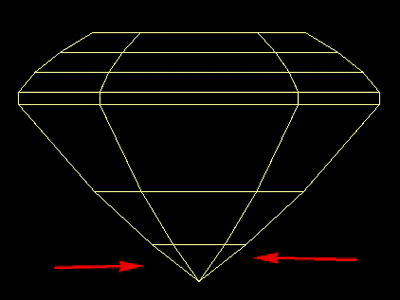
Here are the p3 facets as seen through the table in this wire-view.
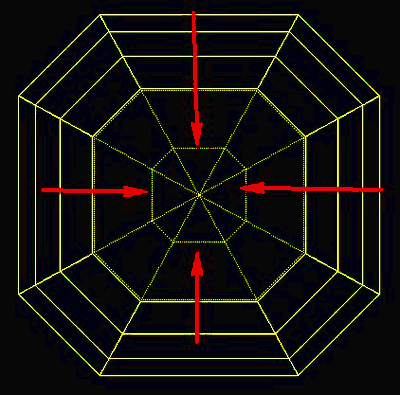
The p3 facets determine the center brightness of a step cut diamond but they also have a large effect on all aspects of the diamond’s performance. Many of the rays that are returned to the eye will have bounced off at least one p3 facet.
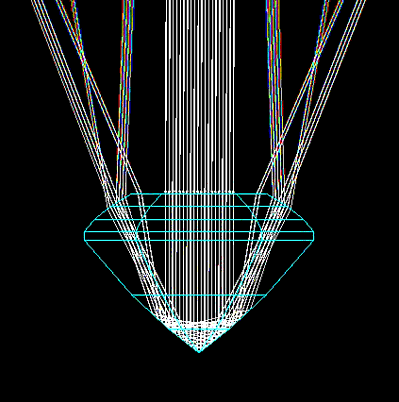
This is what a diamond can look like if these facets are extremely far off from the proper angles. You cannot tell if a diamond has the proper p3 angles by looking at numbers the vast majority of the time. Pictures and an in-person evaluation are needed. The evaluation can either be made in person or by a vendor or appraiser skilled in evaluating step cuts.
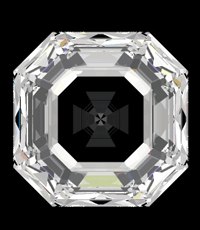
The appearance can be like this when they are just a little “off.”
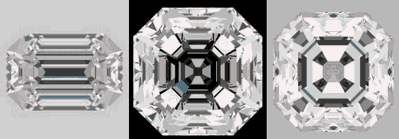
These are some examples with “acceptable” p3 angles.
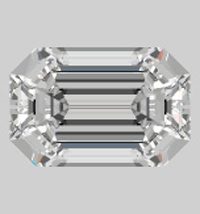
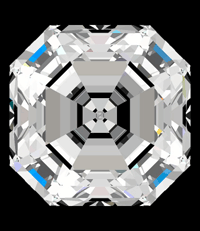
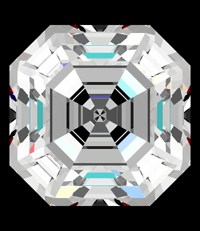
There are 4 results of bad p3 angles that cause center darkness obstruction and leakage or a combination of the 2. In the following images the leakage is white (ASET with backlighting) or the leakage is black (no backlighting). Obstruction is shown in blue.
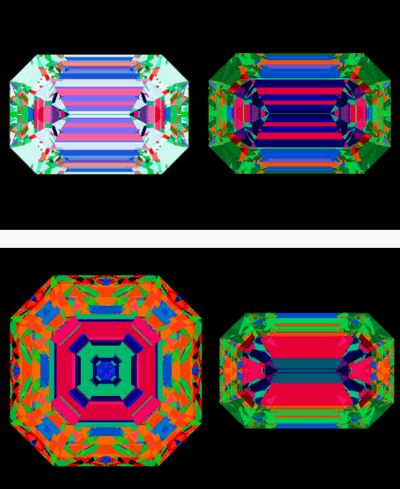
They will show light return in the center of the diamond. Green centers require that they be checked in-person for acceptable center brightness. It indicates that the light return in the center may be reduced. Often, this is not an issue but needs to be evaluated in-person.
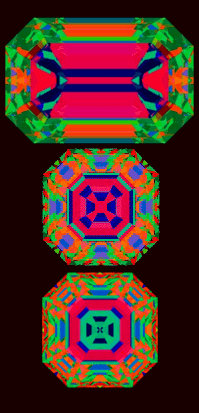
It will show white or black in the center
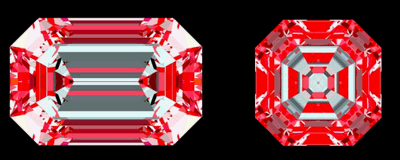
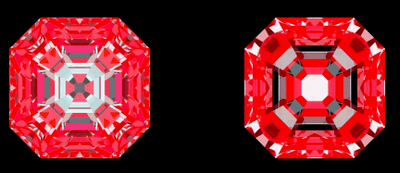
If the ASET and Ideal scope disagree, as in this following example, an in-person evaluation will be needed by a vendor or appraiser skilled in step cuts. The amount of obstruction is determined by viewing distance so the question becomes “is it an issue at normal viewing distances?”
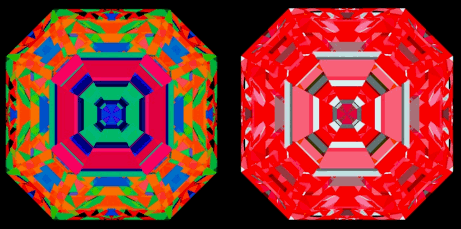
The following pictures show why. The top picture is how this diamond would look under the lighting used for color grading diamonds. The second shows the true nature of the diamond. This is also why you have to be careful of pictures and viewing them with backlighting. Using an Ideal-scope or ASET can eliminate these stones quickly from consideration
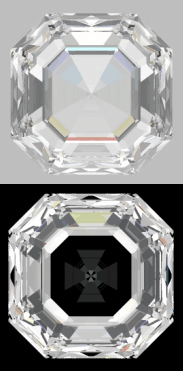
Under some lighting conditions yes; it will mask it if they are only a little off. It still affects how the diamond looks in those lighting environments even when it isn’t apparent. A little later I will introduce 3 videos to show this but the difference is far greater in person. In lighting where the patterns are apparent it will jump out at you.
The facet location and size can be just as important as the angle. The following have exactly the same angles but the pavilion facets are different sizes and locations. This is a big reason why “numbers drool and pictures rule” and will be discussed more in another part of this series.
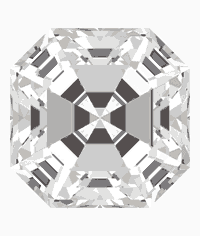
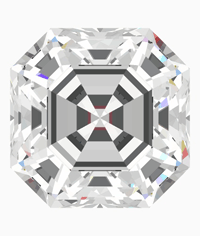
This wire diagram shows the differences in facet locations. The combination seen on the left, above, is in yellow and the one on the right is in red.
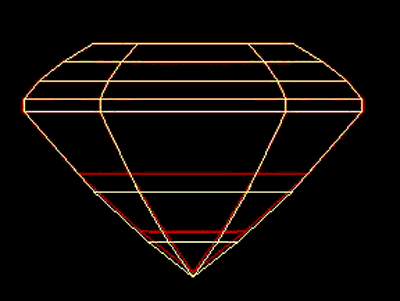
When the center goes dark due to obstruction it is just poor angle selection. Some combinations can be extremely fickle about the precise angles that are successful. For example this one goes dark and has some leakage at 28 degrees, which is well above the critical angle of 24.5 degrees (if the angle is less than this then the facets will act as windows allowing you to see through the pavilion) for diamonds. Other combinations are fine at 28 degrees.
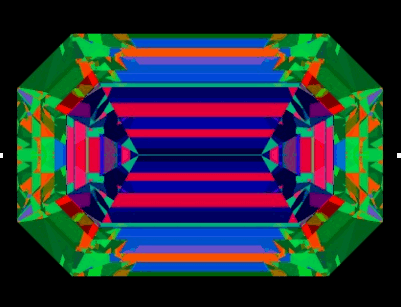
When the center is leaking light in a large area it is the result of a p3 angle that is too shallow and is often the result of cutting for weight retention.
Here is a simulated example of cutting for weight: The p1 and p2 facet sets were run down the stone too far, so there was not enough room for a proper p3 for the given depth of rough – or to avoid the over 70% depth penalty on the common market. With the proper crown height and table size stones deeper than 70% become a specialty market in which very few sellers know how to operate, but this can potentially result in some awesome Asschers and emerald cuts that sell for a premium.
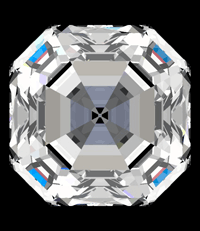
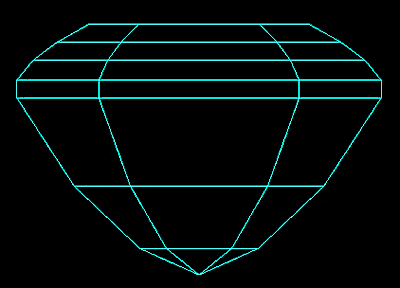
This is what would have happened if the cutter had used the same p1 and p2 facets and cut p3 to the proper angle.
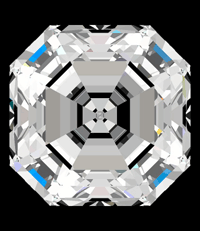
Here is the wire diagram overlying the one above; in yellow. As you can see it is deeper than the one above. The depth would then exceed 70%, reducing the value, or the rough may not be deep enough to cut it.
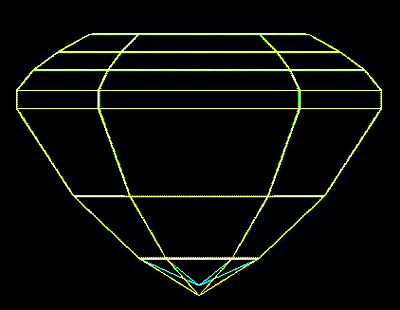
Now let’s make an acceptable Asscher of the same depth leaving as much as possible the same. The best pavilion combination for this crown combo is actually a little shallower than this and is a little brighter.
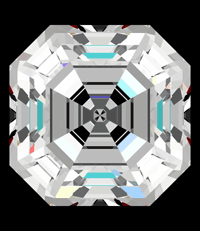
Here is the wire diagram in red overlying the previous 2. As you can see it is clearly going to weigh less after the area outside the red wire frame is removed.
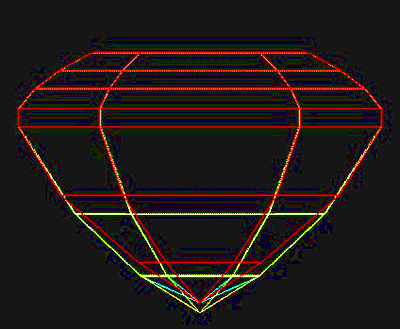
Here is a close up of the p2 and p3 facets from the wire frame.
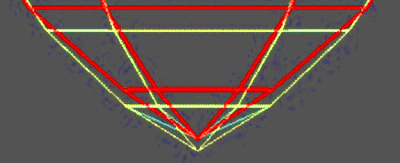
The performance of these 3 combinations can be seen in the following 3 DiamCalc videos. The first video is the “cut for weight” example with the bad p3 angle:
The second video is the same as the first one except it has the proper p3 angle:
The last video is the better but lighter example with higher performance:
The weight of these 3 diamonds is within 1/5 ct of each other but the poorly cut one will sell for more money on the mass market. The cutter could, in today’s market, cut it even lighter if it didn’t go under a “magic number” (weights like 0.50, 1.00, 1.25, etc. at which price jumps) and sell it through the right dealer and make enough to cover the lost weight. This is why there is a premium for well-cut step cuts of the same weight, color and clarity. If it is too close to the “magic weight” then it will be cut over weight due to the economics of today’s market.
The culet is a horizontal flat facet parallel to the table at the bottom of a diamond; it is absent in a diamond with a pointed culet and is too small to see and so not a factor face up in a lot of diamonds. When it is Open(not pointed) on an Asscher it can show up as a small dark spot in the ASET and a small white spot in the IS image in the center of the diamond. It is not a defect and should be comparatively very small to the rest of the stone. In an emerald cut it will show up as a very narrow line in the center of the diamond in the IS and ASET images. This will be discussed in more detail in another part of this series.
For all the technical math behind the critical angle see here:
http://en.wikipedia.org/wiki/Total_internal_reflection#Critical_angle
In simple terms if the facet angle is below the critical angle it acts like a window and does not return light. Here are some images of a combination with the p3 angle well below the critical angle. Notice the area the red arrow points to is very close to the color of the background. This can be used to detect leakage but one needs to be very familiar with such photo setup results to make the call.
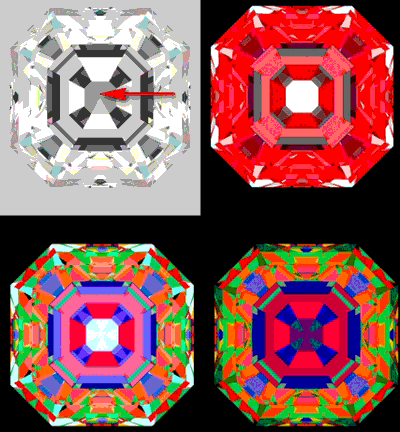
One quick way to see if the p3 angles are under the critical angle; without tools is to hold the loose diamond over a brightly colored background.
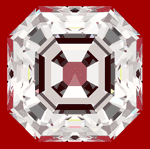
Above critical is safe? NO! Remember there are 2 effects of a bad p3 angle; obstruction and leakage. This combo is 6 degrees above critical but it is too dark in the center. If someone tells you it is ok just because it is above the critical angle they are wrong.
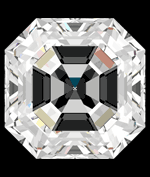
This one is 3.5 degrees over critical and is showing leakage from the p3 facets.
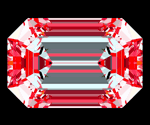
This is the shallower “cut for weight” stone from earlier. As you can see there is a lot of leakage with very little light return from the p3 facets. With this combination the p3 angle is just below the critical angle. Notice you still get some secondary light return and table glare that keeps it from going totally dark.
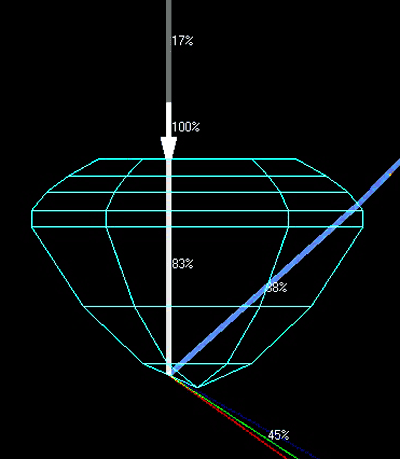
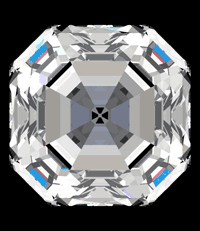
This is the second example from earlier: the deeper heavy stone with a better p3 angle. Notice that the light return is much higher and heading in the right direction. Also notice that the secondary return is heading out the side of the stone.
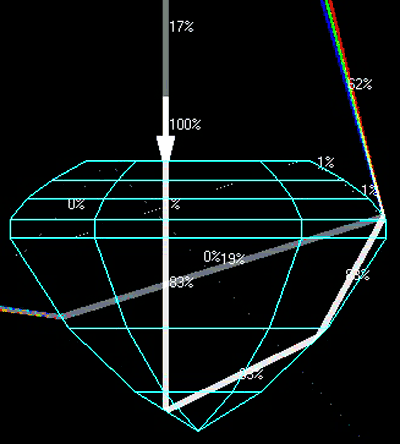
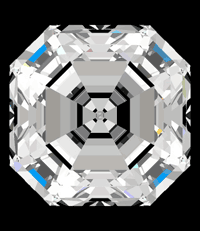
This is the example of a much better but lighter cut. Notice that the light return is stronger still and that the secondary light return is headed in a useful direction. Simply put, this combination directs more light out the top of the diamond than the previous two. Going about 2 percent shallower in overall depth with different pavilion angles would make it even better.
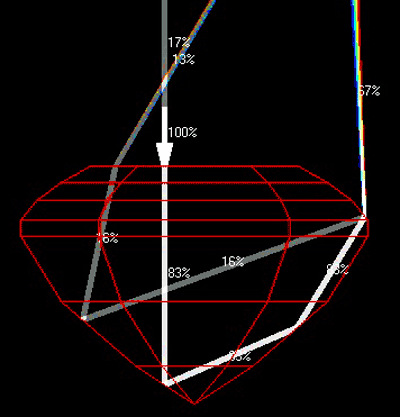
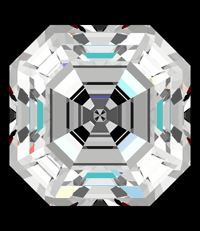
When writing this article I did my best to make it easy to understand and technically correct. My goal is to arm the reader with the knowledge of what to look for as opposed to presenting a complete set of proofs. When given a choice between a full technical explanation and easy-to-understand I chose easy-to-understand. I would like to thank those who helped edit this article:
Garry Holloway
John Pollard
Neil Beaty
DiaGem
Thank you for reading my article and a huge thank you to Andrey for allowing me the opportunity to share this with you.
Karl
Discuss the article here